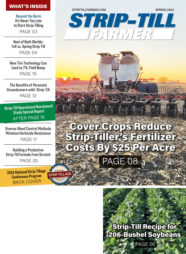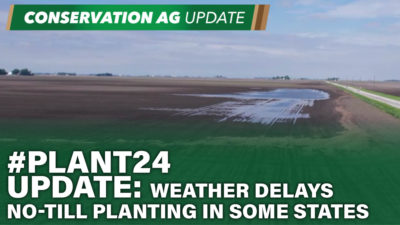Mike Verdonck, “Building Cover Crop Biomass Through Roots, Not Shoots”
For Canadian strip-tiller Mike Verdonck, weed pressure, erosion and a reliance on heavy herbicide and fertilizer applications are all symptoms of “sick” soil. The antidote? Reducing tillage, moving to a yearround, multi-species cover cropping system and putting a focus on rebuilding and maintaining soil health. Verdonck farms 2,500 acres of mostly corn and soybeans near Montreal, Quebec. Farming heavy clay soils, his latitude exposes him to difficult climate challenges, compounded by more than a decade of conventional tillage practices. “Soils will always feed themselves first,” he says. “So microorganisms, if you give them the chance, will use 90% of their energy to rebuild their habitat with only 10% going to the crop itself.” The transition hasn’t been easy, but Verdonck details how his commitment to building biomass through intense cover cropping methods that include inter-cropping, bio strip-till and seeding permanent covers, have shaped his philosophy of building soil health through “roots, not shoots.”
Scott Foxhoven, “Banding vs. Broadcast: Digging Into the Benefits, Barriers & Breakthroughs”
Applying fertilizer beneath the soil surface is often the cornerstone of a strip-till system, and understanding the economic and soil health benefits of banded nutrients is key to capitalizing on the value. Putting metrics behind the application methods is a focus of University of Illinois graduate research assistant Scott Foxhoven, who conducts intensive nutrient management trials comparing banded and broadcast fertilizer applications. For the last 3 years, Foxhoven has led replicated plot research assessing the impact of banded potassium and nitrogen on crop response, including placement in proximity to the seedbed and the safety of applying high-salt fertilizers in the row ahead of planting. Foxhoven shares results of new research which digs into the details of why and how banded fertilizer application can benefit a strip-till system.
Jesse Stoller, “Crunching the Numbers on Custom Strip-Till: Economic Opportunities & Advantages”
While many farmers purchase and maintain their own strip-till rigs, some prefer an alternative investment in the practice. Custom strip-tilling is an emerging business in parts of the U.S., and can be a cost-effective option for new strip-tillers to get started with the practice. Count Kentland, Ind., custom operator Jesse Stoller is among those who is seeing measurable return on his investment in custom striptilling, with increasing interest among farmers looking into alternative tillage practices to widen planting windows and compensate for cool, damp field conditions. The Stoller family started strip-tilling in 2014 on their 4,000-acre operation and in 2020. Stoller breaks down the structure of his custom strip-tilling operation, to include pricing and payback, along with entry-point advice and tips for test driving the practice.
David Hula “Secrets to Breaking Through the 300-Bushel Barrier with Strip-Till”
Shattering yield barriers is part of David Hula’s DNA. The Charles City, Va., farmer is known for his record-breaking corn yields,
but the results are not based on repetition. Rather, it’s Hula’s willingness to embrace change and accept the challenges of adopting a new farming philosophy. Starting in 2018, the long-time no-tiller began transitioning corn acres on his operation to strip-till, seeking more consistency in early emergence, targeted fertilizer placement and yield growth. Hula’s evolving strip-till system contributed to his capturing the 2019 National Corn Growers Assn. high corn yield title with a record of more than 606 bushels per acre. “As we got to yield barriers, we were introduced to strip-till and we played with a few acres, banded some fertilizer and planted our corn crop into the strips,” he says. “The first year, in the very first field, we saw a 37 bushel per-acre yield increase, and overall, what we consistently saw is emergence quality with better seedbed preparation with strip-till.” Hula kicks off the 2020 National Strip-Tillage Conference, analyzing the operational challenges, economic gains and growth potential of transitioning to strip-tilled corn.
Mike Petersen, “Digging Into Compaction Causes, Contributors & Solutions”
Compaction is a reality more farmers have been forced to face, especially during the last few years as excessive moisture condensed the window of opportunity for planting and harvest. With farmers having to explore alternative tillage practices to alleviate compaction, many may be taken outside of their comfort zone to find a solution. But is it the right solution? Agronomist Mike Petersen has led a 2-year research study comparing the causes and remedies for compaction in strip-till, no-till and conventional tillage systems across 3 states, in 8 different soil types from loamy sand to silty clay. “When we go into a row cropped field, we’re looking at the guess row, where the plant is growing and in the traffic row, every 2 inches down from the surface to a depth of 14 inches to provide a detailed profile of soil resistance.” Petersen presents results of the ongoing compaction research as well as his advice on how to solve current compaction problems and prevent the risk in the future
Brandon Hunt, “Scaling Strip-Till Value to Large Acreage Operations”
As a fourth generation farmer, but the first to solely focus entirely on managing the family’s 11,000-acre operation near Herndon, Ky., Brandon Hunt appreciates how innovation is born out of experimentation. After graduating from college, Hunt permanently returned to the family farm — formed in the 1950s — which raises primarily corn, soybeans and wheat, along with smaller amounts of tobacco and hemp. He recently completed a 3-year study on 125 acres comparing banded fertilizer application vs. spreading to gain more understanding on nutrient efficiencies of banding 8 inches deep at different rates vs. surface application. Hunt is currently conducting trials with cover crops, which have become an increasingly important part of the operation. Seeding cereal rye in mid-October to November after harvesting double-cropped soybeans, Hunt then likes to strip-till ahead of planting corn. Hunt shares some of the transitional lessons learned implementing strip-till on a large-scale farm operation, along with results of recent onfarm cover-cropping and nutrient management trials.






Post a comment
Report Abusive Comment